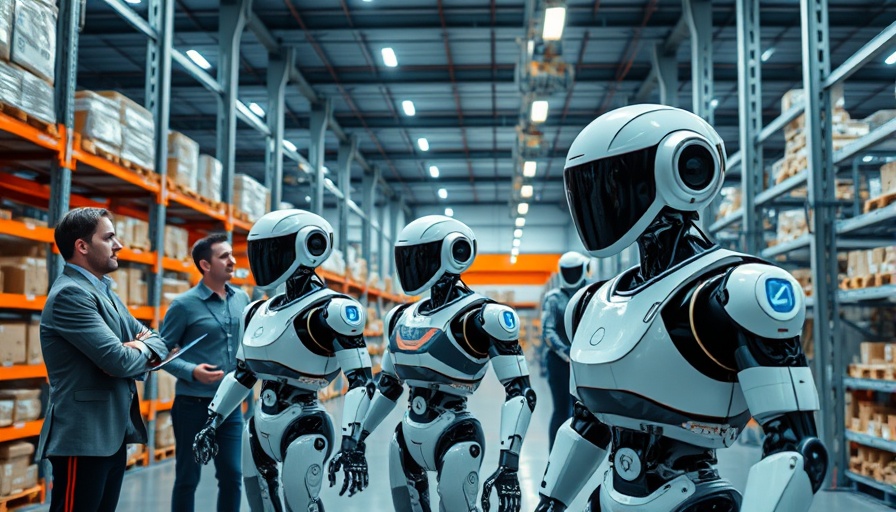
The Rise of Automation: A New Era in Amazon Warehousing
Amazon is on the verge of a historic milestone that could reshape the landscape of labor in the retail and logistics sectors. With reports indicating that the company is about to equal the number of robots deployed in its warehouses to that of human employees—an impressive statistic given Amazon's workforce of approximately 1.56 million—it's clear that automation has reached a pivotal moment.
Understanding the Automation Explosion
The Wall Street Journal reported that Amazon has deployed over one million robots across its facilities, and with projections indicating the potential for these machines to outnumber human workers soon, it raises critical questions about the future of work. As Rueben Scriven from Interact Analysis puts it, Amazon is "one step closer to that realization of the full integration of robotics." This seamless integration is not merely about efficiency; it's about strategically reshaping workplace dynamics.
The Challenges and Benefits of Automation
From a small business owner's perspective, the rapid automation at Amazon presents both challenges and opportunities. While the use of robots in fulfilling orders and maintaining inventory is improving productivity and easing workloads for human workers, it also signals a broader trend that could lead to fewer job opportunities in the long run.
For example, while some Amazon workers, like Neisha Cruz, have reported fewer physical demands on their roles due to robotic assistance, the overall concern remains that the evolution of these bots will eliminate traditional warehouse jobs. The average employee count at Amazon's fulfillment centers has notably decreased, which raises concerns about job security and income stability for many.
Response from Workers and Society
The incorporation of robotics does not come without its criticisms. Although there are claims that automation creates higher-paying jobs, a deeper analysis reveals a misleading narrative, as reported by the New York Times. Contrary to the idea that new supervisory roles will sufficiently replace the lost manual positions, many fear the reduction in human labor will be significant and potentially catastrophic.
The push towards automation can indeed create a more streamlined working process. With 75% of Amazon's global deliveries currently assisted by robotics, businesses must adapt to these shifts in operational norms if they wish to compete with giants like Amazon.
Future Predictions: What the Data Reveals
Looking ahead, experts suggest that as the trend of automation continues, industries must brace for profound changes. The data showcases a stark increase in the number of packages handled per employee, skyrocketing from approximately 175 packages in 2016 to about 3,870 by 2025. Such growth necessitates that organizations rethink staffing strategies and invest in new types of employee training that can keep pace with advancing technology.
Moreover, the creation of positions centered around robot maintenance and operation reflects how the workforce dynamics are evolving. As businesses lean into technology, small business owners must consider how to integrate automation into their operations effectively while keeping their workforce engaged and productive.
Emotional and Ethical Implications
Automation and robotic integration evoke a multitude of emotional responses among employees and employers alike. On one hand, there’s excitement about efficiency and new roles; on the other hand, there’s anxiety about job displacement and ethical considerations surrounding the workforce. Companies must address not only the economic implications of automation but also the human element—how their changes impact morale, job satisfaction, and the community.
Actionable Insights for Small Business Owners
For small business owners looking to stay relevant in an increasingly automated world, here are a few actionable insights:
- Invest in training: Equip your employees with skills that complement automation rather than compete against it. Focus on tech skills and supervisory roles.
- Embrace flexible automation: Utilize systems and tools that integrate smoothly with human labor, enhancing productivity without sidelining your workforce.
- Prioritize employee wellbeing: Consider how shifting roles and responsibilities impact your team, ensuring that morale remains high amidst changes.
In navigating this landscape, proactive steps can position small businesses favorably in the face of a robotic future.
Conclusion: Preparing for Tomorrow
The integration of robots in Amazon’s warehouses is more than a technological advancement; it's a phenomenon that reflects a rapidly evolving industrial landscape. As these changes unfold, small business owners must be vigilant in understanding the implications and opportunities that arise from automation. Embracing a forward-thinking approach to operations and employee relations will not only secure their place in the market but also contribute positively to the larger community and workforce.
 Add Row
Add Row  Add
Add 




Write A Comment